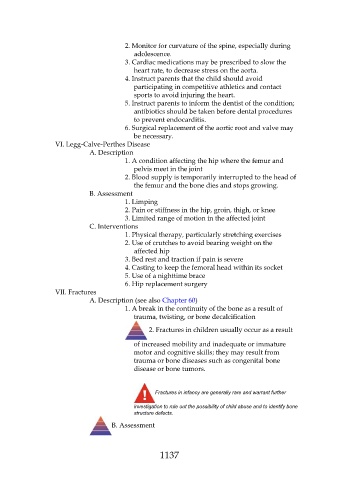Page 1137 - Saunders Comprehensive Review For NCLEX-RN
P. 1137
2. Monitor for curvature of the spine, especially during
adolescence.
3. Cardiac medications may be prescribed to slow the
heart rate, to decrease stress on the aorta.
4. Instruct parents that the child should avoid
participating in competitive athletics and contact
sports to avoid injuring the heart.
5. Instruct parents to inform the dentist of the condition;
antibiotics should be taken before dental procedures
to prevent endocarditis.
6. Surgical replacement of the aortic root and valve may
be necessary.
VI. Legg-Calve-Perthes Disease
A. Description
1. A condition affecting the hip where the femur and
pelvis meet in the joint
2. Blood supply is temporarily interrupted to the head of
the femur and the bone dies and stops growing.
B. Assessment
1. Limping
2. Pain or stiffness in the hip, groin, thigh, or knee
3. Limited range of motion in the affected joint
C. Interventions
1. Physical therapy, particularly stretching exercises
2. Use of crutches to avoid bearing weight on the
affected hip
3. Bed rest and traction if pain is severe
4. Casting to keep the femoral head within its socket
5. Use of a nighttime brace
6. Hip replacement surgery
VII. Fractures
A. Description (see also Chapter 60)
1. A break in the continuity of the bone as a result of
trauma, twisting, or bone decalcification
2. Fractures in children usually occur as a result
of increased mobility and inadequate or immature
motor and cognitive skills; they may result from
trauma or bone diseases such as congenital bone
disease or bone tumors.
Fractures in infancy are generally rare and warrant further
investigation to rule out the possibility of child abuse and to identify bone
structure defects.
B. Assessment
1137

